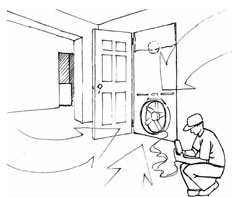Home Energy Auditors, Raters, and Contractors
Before making major efficiency improvements to your house, find out from a pro where and why energy is being wasted and what you should do about it. Today’s home energy specialists — sometimes called house doctors, energy auditors, raters, or home performance contractors — go beyond simple checklist audits. They study the building as a system, performing full checkups that are designed to address overall safety, comfort, energy efficiency, and indoor air quality. After all, many construction flaws can result in high energy bills, and some conditions that cause high energy bills can compromise building safety or resident health and comfort (more about that in the ventilation section). For example, home performance contractors can diagnose and fix uneven heat distribution while lowering energy costs, or reduce cold drafts and moisture condensation problems while reducing energy bills.
These contractors use sophisticated equipment, like blower doors and infrared cameras, to help pinpoint air leaks and areas with inadequate insulation. Auditors that are properly certified should also test and tune-up your heating and cooling equipment, and check for duct leakage (see Ventilation and Heating). These professionals know what to look for in both newer and older houses, and the investment in their time is usually well worth the cost. They will often perform the air sealing work as they go, and can usually connect you with qualified contractors to complete major work or work with your own contractor to get the right work done. Many utility companies offer incentives to reduce the cost of a thorough home energy assessment.
A home energy rating entails the same kind of onsite diagnostic tests that an energy auditor would do; but with a rating, your house will be given a point score between 1 and 100 that compares your house to others. Energy ratings are used more often for new homes to obtain an ENERGY STAR distinction or energy mortgage, but the tool can be useful for existing homes as well. A rater will look at your energy bills to complete a full analysis of your home’s energy costs and improvement options, and the score acts as a tool to evaluate and pinpoint the most cost-effective improvements. Find a rater that is certified by RESNET.
Common Home Performance Diagnostic Tests
A blower door is used to determine your home’s airtightness. It is a powerful fan that mounts into the frame of an exterior door and pulls air out of the house in order to lower the inside air pressure. While operating, the auditor can determine the air infiltration rate and better identify specific leaks around the house. Make sure your auditor is using a “calibrated” blower door.
A duct blaster is sort of like a blower door for your duct system, except instead of pulling air out, it uses a fan to force air into the system until it reaches a standard pressure. The fan is attached to one entry into the duct system while all other registers are temporarily sealed off. While under pressure, the instrument can detect how much air is leaking from the ductwork. See the Building Envelope section for more on duct sealing.
Using a digital infrared camera is a very powerful way to detect both thermal defects and air leakage. Infrared cameras measure surface temperatures — the camera “sees” variations in heat instead of light, and expresses warmer areas with warmer colors. So you can actually see if, for example, a portion of your wall is missing insulation, without having to drill a hole. Interpreting the images correctly, however, depends on experience and understanding the indoor and outdoor conditions.
In select areas, there may be home performance contractors trained under the Home Performance with ENERGY STAR program. This is a U.S. DOE program that partners with local states, utilities and municipalities to train a network of contractors to conduct home energy improvements in existing homes. These contractors act as general managers that oversee the whole process from testing through installation of new equipment. Any improvements purchased may be partially subsidized by the local agency up to a certain dollar amount or qualify for low-interest financing.
If you are a renter, encourage your landlord to have an energy audit and follow through on the recommended energy improvements. You might offer to help your landlord by arranging for the audit and even doing some of the work in exchange for rent. After all, if you pay for heating, air conditioning, and electricity, energy improvements are very much in your interest. Even if your landlord won’t pay for energy conservation projects, many of the suggestions in this section are inexpensive enough that they’ll pay for themselves in just a year or two, justifying your out-of-pocket expenditures.
Depending on your income, you may qualify for a free energy audit and energy efficiency improvements to your home through the Weatherization Assistance Program.
Learn more about contractor services, home improvement incentives in your state, and local contractors certified by the Building Performance Institute.
Or try finding an energy rater through RESNET. These contractors should also be able to discuss energy-efficient mortgages.
Find out whether Home Performance with ENERGY STAR is available in your area, on the ENERGY STAR website under “Home improvement.”


